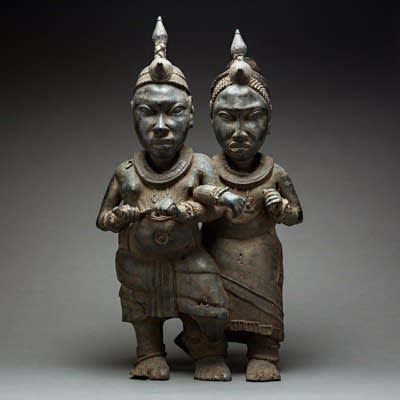Ife Style Bronze Sculpture of aKingand Queen, 20th Century CE
Brass
15 x 26.5
AM.0428 (LSO)
This impressive couple is made in the style of the Ife people of Nigeria. It comprises a single bronze moulding of two short, powerfully-built couple standing side by side, their...
This impressive couple is made in the style of the Ife people of Nigeria. It comprises a single bronze moulding of two short, powerfully-built couple standing side by side, their arms interlocked. They are dressed in tunics brought in around their waists, scarifications, extensive jewellery including neck-rings and bracelets, and impressive tall crows with a central diadem and a spike on the apex. The figure on the right has wrapped his right foot around the back of the others’ left heel.
Ife was perhaps the single most important culture in West Africa. At its peak in the first half of the second millennium AD, it is particularly noted for its fine metalwork, notably brass casting, a tradition inherited by the later Benin and Yoruba polities. Unusually for African art, their works were often extremely lifelike and naturalistic, which disproved many art historians’ assertions that African art was ‘primitive’ due to lack of ability. They are well known for the stripes that adorn the faces of their most impressive sculptures, naturalistic heads. Most of their artistic oeuvres depict the ruling elites (especially the Obas – known as Oonis in Ife) as well as zoomorphic and general anthropomorphic figures, in addition to ‘cult’ objects of various forms and uncertain significance.
This is a reiterative piece in that the Ife, as a sociopolitical group, were technically extinct at the time this was made. However, their distinctive styles live on in later works by their descendents, such as the Yoruba and other Nigerian groups. This is an impressive piece of African art.
Ife was perhaps the single most important culture in West Africa. At its peak in the first half of the second millennium AD, it is particularly noted for its fine metalwork, notably brass casting, a tradition inherited by the later Benin and Yoruba polities. Unusually for African art, their works were often extremely lifelike and naturalistic, which disproved many art historians’ assertions that African art was ‘primitive’ due to lack of ability. They are well known for the stripes that adorn the faces of their most impressive sculptures, naturalistic heads. Most of their artistic oeuvres depict the ruling elites (especially the Obas – known as Oonis in Ife) as well as zoomorphic and general anthropomorphic figures, in addition to ‘cult’ objects of various forms and uncertain significance.
This is a reiterative piece in that the Ife, as a sociopolitical group, were technically extinct at the time this was made. However, their distinctive styles live on in later works by their descendents, such as the Yoruba and other Nigerian groups. This is an impressive piece of African art.
